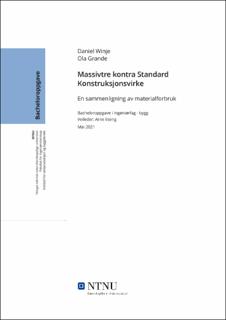| dc.contributor.advisor | Ilseng, Arne | |
| dc.contributor.author | Winje, Daniel | |
| dc.contributor.author | Grande, Ola | |
| dc.date.accessioned | 2021-09-24T19:22:09Z | |
| dc.date.available | 2021-09-24T19:22:09Z | |
| dc.date.issued | 2021 | |
| dc.identifier | no.ntnu:inspera:77257390:81861906 | |
| dc.identifier.uri | https://hdl.handle.net/11250/2782273 | |
| dc.description.abstract | Bakgrunnen for oppgaven var et forslag fra Moelven Limtre, om å sammenligne massivtre med standard konstruksjonsvirke, spesielt med tanke på forbruk av material. Med dette som utgangspunkt ble det laget en oppgave med formål om å se på forbruket av material, og oppbinding av CO2-ekvivalenter i bæresystemene.
For å få til en sammenligning, besto fremgangsmåten av flere delsteg. Med utgangspunkt i statistikk fra SSB, ble det lagt føringer for størrelsen på modellene. Modellene skulle ha lik bredde, lengde, og høyde. Hovedvekten var på dimensjoneringen av bæresystemene til de forskjellige modellene. Tallgrunnlaget for selve sammenligningen mellom løsningene, ble hentet ut fra BIM-modellene. Selve BIM-modellene, ble laget i Revit.
Resultatene for de forskjellige modellene, varierte mellom massivtremodellene og konstruksjonsvirkemodellene. Over 2.etg var det minste forbruket 45,5 m3, og det største 212 m3. Selve oppbindingen av CO2 følger forbruket av material. Største oppbinding av CO2 var på -1,3E+05kg, og minste var -5,4E+03kg.
Konklusjonen er at sammenlignet med massivtre kan et bindingsverk redusere forbruket av trevirke med 78,6%. Denne modellen binder 80% mindre CO2 sammenlignet med massivtremodellen. For en kombinasjonsmodell med massivtre i dekke, og bindingsverk i vegg kan forbruk av trevirke reduseres med 12,4%. For denne modellen bindes det 7,69% mindre CO2. | |
| dc.description.abstract | The thesis is a result of a theme proposed by Moelven Limtre. They wanted to look into the usage of materials in constructions using Cross Laminated Timber (CLT for short) and standard construction timber. With this in mind, we decided to focus on load-carrying systems. Thus, the primary purpose is a comparison of the materials and GWP-impact between the systems.
To make a comparison, the method used consisted of multiple steps. First, based upon statistical data provided by SSB, we decided on building shape and size. They were to have the same width, length, and height. Second, the main emphasis of the thesis was on the dimensioning of the load-carrying systems. Last, we took a numerical basis for the comparison from the BIM models made in Revit.
The results between the systems had a variation of materials used, from 45,5m3 and 212m3. GWP-impact followed the material usage. The most extensive storage of CO2 was -1,3E+05kg, and the smallest -5,4E+03kg.
The difference between a model of CLT and one with standard construction timber is at best at 78,6%. A standard construction timber model binds 80% less C02 than a CLT model. Combining the two materials reduces the usage of timber by 12,4%—such a model stores 7,69% less CO2. | |
| dc.language | nob | |
| dc.publisher | NTNU | |
| dc.title | Massivtre kontra Standard Konstruksjonsvirke | |
| dc.type | Bachelor thesis | |
